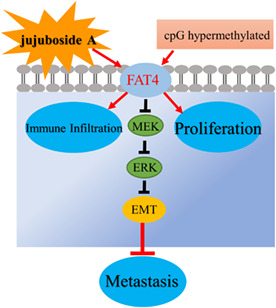- Record: found
- Abstract: found
- Article: found
Increased expression of FAT4 suppress metastasis of lung adenocarcinoma through regulating MAPK pathway and associated with immune cells infiltration

Read this article at
Abstract
FAT4 is an extremely large atypical cadherin with crucial roles in the control of planar cell polarity (PCP) and regulation of the Hippo signaling pathway. Our study aims to clarify the FAT4 expression patterns, as well as the significance of FAT4 in predicting the prognosis and cancer immunity to non‐small cell lung cancer (NSCLC). FAT4 mRNA and protein expressions were both underregulated in NSCLC and associated with poor prognosis in both lung adenocarcinoma (LUAD) and lung squamous cell carcinoma (LUSC). In addition, overexpress FAT4 with jujuboside A (JUA) or knockdown FAT4 with siRNA regulated the metastasis of LUAD through MAPK pathways. Moreover, the FAT4 expression included multiple immunological components to promote an immunosuppressive tumor microenvironment (TME). Furthermore, a study of the TCGA‐LUAD cohort's DNA methylation results showed that most FAT4 DNA CpG sites were typically hypermethylated in NSCLC relative to the normal lung tissue. The DNA CpG sites cg25879360 and cg26389756 of FAT4 were found to be strongly associated with FAT4 expression in LUAD through the correlation study. In conclusion, this is the first to report the potential function of FAT4 in NSCLC. Hence, FAT4 could be used as a promising prognostic and immunological biomarker for NSCLC.
Abstract
Overexpression of FAT4 combined with jujuboside A (JUA) inhibits the metastasis of LUAD tumor cells through regulating MAPK pathways. Aberrant expression of FAT4 assocites with the tumor cell proliferation and immune infiltration in LUAD. Hypermethylated of CpG causes FAT4 expression decreased in LUAD.
Related collections
Most cited references29
- Record: found
- Abstract: found
- Article: not found
Cancer Statistics, 2021
- Record: found
- Abstract: found
- Article: not found
Systematic and integrative analysis of large gene lists using DAVID bioinformatics resources.
- Record: found
- Abstract: found
- Article: not found
